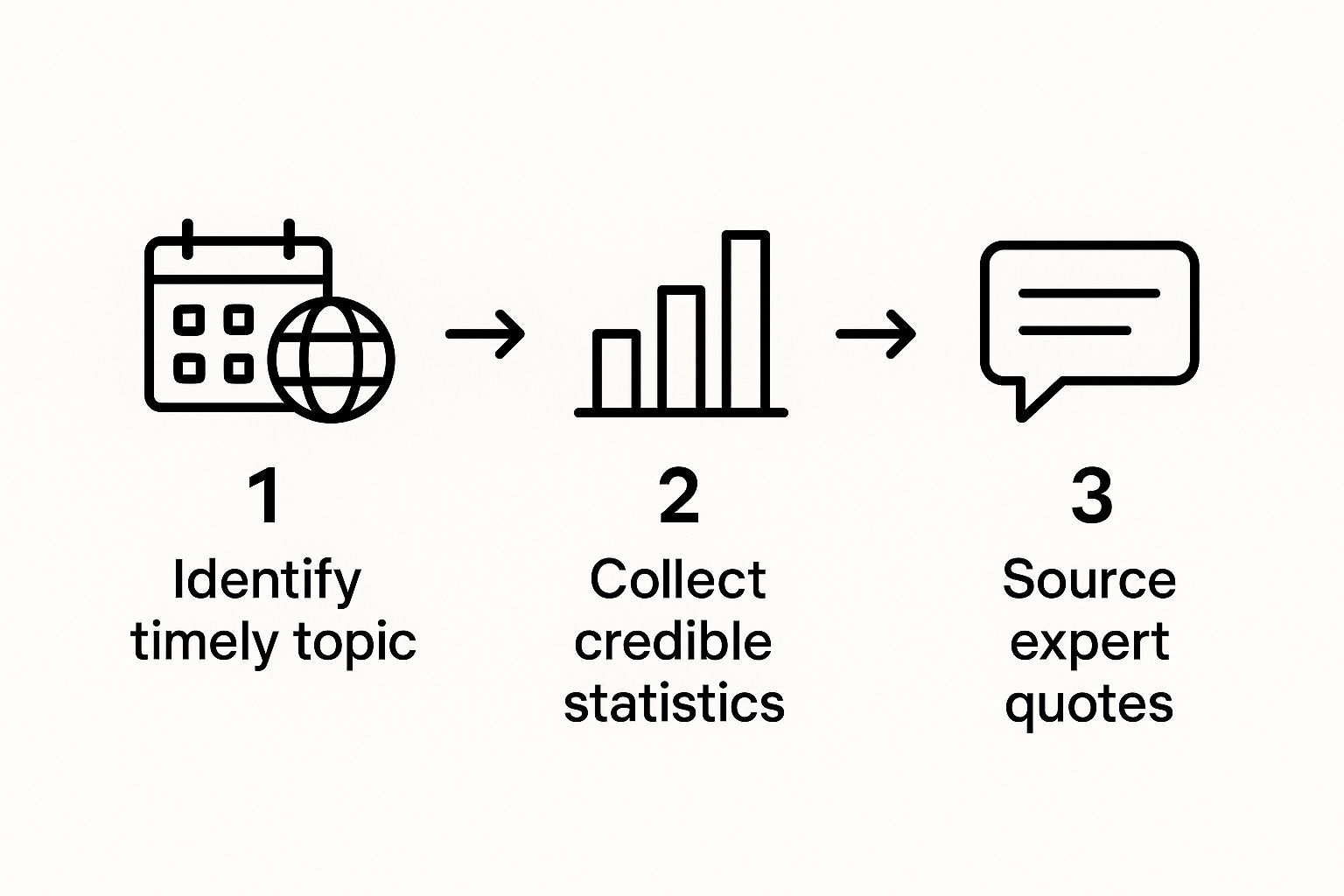
Writing an editorial can feel daunting. You have a strong opinion, but how do you turn it into a persuasive argument that doesn't just get lost in the noise? For many marketers and creators, the challenge is crafting a piece that blends factual reporting with a powerful point of view, ultimately aiming to sway public opinion or inspire action. You're not just stating what happened; you're explaining what we should do about it. This guide breaks down exactly how to write an editorial that is thoughtful, evidence-backed, and truly makes an impact.
What Makes an Editorial So Powerful?
Ever read a piece that completely shifted your perspective on an issue? That's the power of a well-crafted editorial. It represents the official stance of a publication or brand, designed to persuade, challenge, and lead a conversation. Many creators worry their opinion pieces will come across as a simple social media rant, but the key difference lies in structure and evidence. A great editorial builds a compelling case that earns reader respect and starts a meaningful dialogue. Master this, and you'll be able to create truly engaging content that captivates audiences.

Step 1: Find Your Angle and Gather Evidence
A strong editorial starts long before you write the first sentence. The first step is to choose a timely, relevant topic that resonates with your audience—whether they're industry peers or the general public. Look at current events, ongoing industry debates, or persistent problems within your niche. The goal is to find a unique perspective or angle that hasn't already been covered extensively. A fresh take is what makes your piece stand out.
But an opinion without proof is just noise. Your argument needs a solid foundation of credible evidence. This means digging for reliable statistics, finding compelling quotes from experts, and uncovering historical context to support your claims. For marketers, this could be citing recent consumer trend reports; for agency owners, it might be referencing new platform policy changes. If this research phase feels like a grind, our guide on how to overcome writer's block can help you push through.

Step 2: Structure Your Argument for Maximum Impact

The most persuasive editorials are meticulously built. Think of yourself as an architect designing a blueprint for your argument. A logical structure guides the reader from the problem directly to your proposed solution, making your opinion feel inevitable and correct.
This framework isn't meant to be restrictive. Instead, it ensures your argument flows logically, making it easy for readers to follow your train of thought.
The Core Components of an Editorial
Your introduction must grab the reader's attention, clearly define the problem, and state your thesis. Be direct. From there, each body paragraph should tackle a specific point, reinforcing it with the solid evidence you've gathered. This is where your research shines.
One of the most powerful steps is to directly address counterarguments. By acknowledging and dismantling opposing views, you show you’ve done your homework. For instance, a marketer arguing for a bigger content budget should acknowledge the counterargument about immediate ROI and then use data to prove long-term value. This significantly boosts your credibility.
Finally, your conclusion should be more than a summary. It's your last chance to leave an impression with a memorable call to action that inspires people to think, discuss, or get involved.
The Anatomy of a Persuasive Editorial
| Component | Purpose | Key Elements to Include |
|---|---|---|
| The Hook & Thesis | To grab the reader's attention immediately and state your main argument clearly. | A compelling opening sentence, a concise statement of the problem, and a clear thesis that sets the stage for your argument. |
| The Body Paragraphs | To build your case with evidence and logical reasoning, one point at a time. | A clear topic sentence for each paragraph, supporting evidence (facts, stats, expert quotes), and a smooth transition to the next point. |
| The Counterargument | To acknowledge and refute opposing viewpoints, strengthening your own position. | A fair summary of the main counterargument, followed by a logical rebuttal supported by evidence. |
| The Conclusion | To summarize the argument and compel the reader to take action or change their perspective. | A restatement of your thesis in new words, a summary of your main points, and a powerful, actionable call to action. |
By building your editorial around this structure, you create a cohesive and convincing piece that not only informs but also persuades.
👉 Try MediaWorkbench.ai for free – schedule your posts and generate AI content in one place!
Step 3: Master the Art of Persuasive Language
Facts provide the foundation, but your language builds the bridge to your reader’s mind. To be truly convincing, you need a tone that is authoritative yet relatable, connecting with your audience without sounding condescending. It's about finding the sweet spot between emotional appeal and logical reasoning. To do this, lean into powerful persuasive writing techniques that give any great editorial its persuasive power. For example, using rhetorical questions can engage the reader, while using vivid analogies can make a complex topic more accessible for a marketing audience. Your goal is to tell a compelling story that resonates on a human level while being firmly rooted in facts. For a deeper dive, check out our guide on copywriting tips for beginners.
Step 4: Revise and Polish Your Final Draft
The first draft is done, but the real work starts now. Revision is your quality control process. Your primary goal is to fact-check every claim and ensure your argument is airtight. The editorial has been a powerful tool since its rise in 18th-century media, and its impact still depends entirely on credibility. One weak point or inaccurate statistic can undermine your entire piece.
Here’s a practical tip: read your entire editorial out loud. This simple step is the fastest way to catch awkward phrasing and clunky sentences that looked fine on the screen. Finally, get a fresh pair of eyes on it. Ask a colleague or trusted peer to give you honest feedback. They can spot weaknesses in your argument that you’re too close to see, helping you polish your draft until it's ready to publish. If you're looking for more ways to sharpen your writing, you can explore helpful AI tools for content creation.
Your Editorial Writing Questions, Answered
Jumping into editorial writing can bring up a lot of questions. Let's tackle some of the most common ones.
What’s the Difference Between an Editorial and an Op-Ed?
This is a big one. An editorial is the official voice of the publication or organization. It’s typically written by an in-house editorial board and reflects the institution's official stance on an issue. An op-ed (short for "opposite the editorial page") is a guest submission from an outside expert, community member, or public figure. It represents their personal view, not the publication's. Think of it as the difference between the brand speaking and the brand offering a platform for someone else to speak.
How Long Should an Editorial Be?
Keep it concise. For most newspapers and online publications, the ideal length is between 600 and 800 words. This gives you enough space to build a persuasive, evidence-based case without losing your reader's attention. Any longer, and you risk them clicking away before you’ve made your final, powerful point.
How Do I Handle a Controversial Topic?
Tackling a sensitive issue requires a careful approach. The key is to lead with logic and hard evidence, not pure emotion.
- Acknowledge the other side. Show you've considered the issue from multiple angles. Briefly mention opposing views and then calmly dismantle them with facts.
- Keep your tone rational. Your goal is to persuade, not to provoke. A calm, reasoned argument demonstrates confidence and is always more convincing than an angry one.
Conclusion
Writing a compelling editorial comes down to a clear process: choose a relevant topic, back your opinion with solid evidence, structure your argument logically, and write with persuasive language. By mastering these steps, content creators and marketers can move beyond simple content production and start shaping conversations within their industry. An editorial is your chance to take a stand, demonstrate thought leadership, and inspire your audience to think differently.
Ready to streamline your content creation process? MediaWorkbench.ai provides powerful tools to help you research, draft, and refine your editorials in a fraction of the time. Explore our features and start your free trial today!

